Manifestation of the Early 20th Century Warming in the East-European Plain: Atmospheric Circulation Anomalies and Its Connection to the North Atlantic SST and Sea Ice Variability
Abstract
1. Introduction
2. Materials and Methods
3. Results
3.1. Extreme Hydrological Phenomena and Droughts on the East European Plain in 1920–1940
3.2. Atmospheric Circulation Conditions and Drivers of Summer Warming and Extreme Drought on the EEP during the ETCW Period
3.3. The Link of Summer Warming and EEP Drought in 1920–1940 to Arctic Warming and Changes of Sea Ice Area in the Barents and Kara Seas
4. Discussion
5. Conclusions
Author Contributions
Funding
Data Availability Statement
Conflicts of Interest
References
- Bokuchava, D.; Semenov, V. Mechanisms of the Early 20th Century Warming in the Arctic. Earth-Sci. Rev. 2021, 222, 103820. [Google Scholar] [CrossRef]
- Chylek, P.; Klett, J.D.; Dubey, M.K.; Hengartner, N. The role of Atlantic Multi-decadal Oscillation in the global mean tem-perature variability. Clim. Dyn. 2016, 47, 3271–3279. [Google Scholar] [CrossRef]
- Hegerl, G.C.; Brönnimann, S.; Schurer, A.; Cowan, T. The early 20th century warming: Anomalies, causes, and consequences. WIREs Clim. Chang. 2018, 9, e522. [Google Scholar] [CrossRef]
- Brönnimann, S.; Stickler, A.; Griesser, T.; Ewen, T.; Grant, A.N.; Fischer, A.M.; Ross, T. Exceptional atmospheric circulation during the “Dust Bowl”. Geophys. Res. Lett. 2009, 36, L08802. [Google Scholar] [CrossRef]
- Cook, B.I.; Seager, R.; Miller, R.L. Atmospheric circulation anomalies during two persistent north american droughts: 1932–1939 and 1948–1957. Clim. Dyn. 2011, 36, 2339–2355. [Google Scholar] [CrossRef]
- Cowan, T.; Hegerl, G.C.; Schurer, A.; Tett, S.F.B.; Vautard, R.; Yiou, P.; Jézéquel, A.; Otto, F.E.L.; Harrington, L.J.; Ng, B. Ocean and land forcing of the record-breaking Dust Bowl heatwaves across central United States. Nat. Commun. 2020, 11, 2870. [Google Scholar] [CrossRef]
- Schubert, S.D.; Suarez, M.J.; Pegion, P.J.; Koster, R.D.; Bacmeister, J.T. Causes of long-term drought in the U.S. Great Plains. J. Clim. 2004, 17, 485–503. [Google Scholar] [CrossRef]
- Cook, B.I.; Miller, R.L.; Seager, R. Amplification of the North American “Dust Bowl” drought through human-induced land degradation. Proc. Natl. Acad. Sci. USA 2009, 106, 4997–5001. [Google Scholar] [CrossRef]
- Brönnimann, S. Climatic changes since 1700. In Advances in Global Change Research; Springer: Berlin/Heidelberg, Germany, 2015; Volume 55, p. 360. [Google Scholar]
- Brönnimann, S.; Fischer, A.M.; Rozanov, E.; Poli, P.; Compo, G.P.; Sardeshmukh, P.D. Southward shift of the northern tropical belt from 1945 to 1980. Nat. Geosci. 2015, 8, 969–974. [Google Scholar] [CrossRef]
- Barry, J.M. Rising Tide: The Great Mississippi Flood of 1927 and How it Changed America; Simon & Schuster: New York, NY, USA, 1997; p. 526. [Google Scholar]
- Wegmann, M.; Orsolini, Y.; Zolina, O. Warm Arctic−cold Siberia: Comparing the recent and the early 20th-century Arctic warmings. Environ. Res. Lett. 2018, 13, 025009. [Google Scholar] [CrossRef]
- Wegmann, M.; Rohrer, M.; Santolaria-Otín, M.; Lohmann, G. Eurasian autumn snow link to winter North Atlantic Oscillation is strongest for Arctic warming periods. Earth Syst. Dynam. 2020, 11, 509–524. [Google Scholar] [CrossRef]
- Popova, V.; Matveeva, T.; Bokuchava, D. The Early 20th Century Warming in the East-European Plain Climate: Extreme Drought in 1920–1940, Atmospheric Circulation Anomalies and Links with the Sea Ice Variability. Environ. Sci. Proc. 2022, 19, 57. [Google Scholar]
- Morice, C.P.; Kennedy, J.J.; Rayner, N.A.; Winn, J.P.; Hogan, E.; Killick, R.E.; Dunn, R.J.H.; Osborn, T.J.; Jones, P.D.; Simpson, I.R. An updated assessment of near-surface temperature change from 1850: The HadCRUT5 dataset. J. Geophys. Res. 2021, 126. [Google Scholar] [CrossRef]
- Lenssen, N.; Schmidt, G.; Hansen, J.; Menne, M.; Persin, A.; Ruedy, R.; Zyss, D. Improvements in the GISTEMP uncertainty model. J. Geophys. Res. Atmos. 2019, 124, 6307–6326. [Google Scholar] [CrossRef]
- Harris, I.; Osborn, T.J.; Jones, P.; Lister, D. Version 4 of the CRU TS monthly high-resolution gridded multivariate climate dataset. Sci. Data 2020, 7, 56. [Google Scholar] [CrossRef] [PubMed]
- Schrier, G.; Barichivich, J.; Briffa, K.R.; Jones, P.D. A scPDSI-based global data set of dry and wet spells for 1901–2009. J. Geophys. Res. Atmos. 2013, 118, 4025–4048. [Google Scholar] [CrossRef]
- Allan, R.; Ansell, T. A New Globally Complete Monthly Historical Gridded Mean Sea Level Pressure Dataset (HadSLP2): 1850–2004. J. Clim. 2006, 19, 5816–5842. [Google Scholar] [CrossRef]
- Kennedy, J.J.; Rayner, N.A.; Atkinson, C.P.; Killick, R.E. An Ensemble Data Set of Sea Surface Temperature Change From 1850: The Met Office Hadley Centre HadSST.4.0.0.0 Data Set. J. Geophys. Res. Atmos. 2019, 124, 7719–7763. [Google Scholar] [CrossRef]
- Polyakov, I.V.; Alekseev, G.V.; Bekryaev, R.V.; Bhatt, U.S.; Colony, R.; Johnson, M.A.; Karklin, V.P.; Walsh, D.; Yulin, A.V. Long-Term Ice Variability in Arctic Marginal Seas. J. Clim. 2003, 16, 2078–2085. [Google Scholar] [CrossRef]
- Semenov, V.A.; Matveeva, T.A. Arctic Sea Ice in the First Half of the 20th Century: Temperature-Based Spatiotemporal Reconstruction. Izv. Atmos. Ocean. Phys. 2020, 56, 534–538. [Google Scholar] [CrossRef]
- Huang, B.; Thorne, P.W.; Banzon, V.F.; Boyer, T.; Chepurin, G.; Lawrimore, J.H.; Menne, M.J.; Smith, T.M.; Vose, R.S.; Zhang, H.-M. Extended Reconstructed Sea Surface Temperature, Version 5 (ERSSTv5): Upgrades, Validations, and Intercomparisons. J. Clim. 2017, 30, 8179–8205. [Google Scholar] [CrossRef]
- Olonscheck, D.; Mauritsen, T.; Notz, D. Arctic sea-ice variability is primarily driven by atmospheric temperature fluc-tuations. Nat. Geosci. 2019, 12, 430–434. [Google Scholar] [CrossRef]
- Stroeve, J.; Notz, D. Changing state of Arctic sea ice across all seasons. Environ. Res. Lett. 2018, 13, 103001. [Google Scholar] [CrossRef]
- Strashnaya, A.I.; Maksimenkova, T.A.; Chub, O.V. Agrometeorological features of the 2010 drought in Russia compared to the droughts of previous years. Tr. Gidrometeorol. Nauchno-Issledovatelskogo Tcentra Ross. Fed. 2011, 345, 171–188. (In Russian) [Google Scholar]
- Grant, A.; Brönnimann, S.; Ewen, T.; Griesser, T.; Stickler, A. The early twentieth century warm period in the European Arctic. Meteorol. Z. 2009, 18, 425–432. [Google Scholar] [CrossRef]
- Kumar, A.; Yadav, J.; Mohan, R. Spatio-temporal change and variability of Barents-Kara sea ice, in the Arctic: Ocean and atmospheric implications. Sci. Total. Environ. 2020, 753, 142046. [Google Scholar] [CrossRef] [PubMed]
- Cai, Q.; Beletsky, D.; Wang, J.; Lei, R. Interannual and decadal variability of Arctic summer sea ice associated with atmospheric teleconnection patterns during 1850–2017. J. Clim. 2021, 34, 9931–9955. [Google Scholar] [CrossRef]
- Bokuchava, D.D.; Semenov, V.A. The role of natural fluctuations and factors of external forcing in the Early 20th Century Warming in Northern Hemisphere. Ice Snow 2022, 62, 455–474. (In Russian) [Google Scholar]
- Tokinaga, H.; Xie, S.-P.; Mukougawa, H. Early 20th-century Arctic warming intensified by Pacific and Atlantic multidecadal variability. Proc. Natl. Acad. Sci. USA 2017, 114, 6227–6232. [Google Scholar] [CrossRef]
- Mokhov, I.I. Specific features of the 2010 summer heat formation in the European territory of Russia in the context of general climate changes and climate anomalies. Izv. Atmos. Ocean. Phys. 2011, 47, 653–660. [Google Scholar] [CrossRef]
- Popova, V.V. Summertime warming in the European part of Russia and extreme heat in 2010 as manifestation of large-scale atmospheric circulation trends in the late 20th–early 21st centuries. Russ. Meteorol. Hydrol. 2014, 39, 159–167. [Google Scholar] [CrossRef]
- Kattsov, V.M. (Ed.) The Third Assessment Report on Climate Change and Their Consequences on the Territory of the Russian Federation; Roshydromet: St. Petersburg, Russia, 2022; pp. 70–75. (In Russian) [Google Scholar]
- Laine, A.; Nakamura, H.; Nishii, K.; Miyasaka, T. A diagnostic study of future evaporation changes projected in CMIP5 climate models. Clim. Dyn. 2014, 42, 2745–2761. [Google Scholar] [CrossRef]
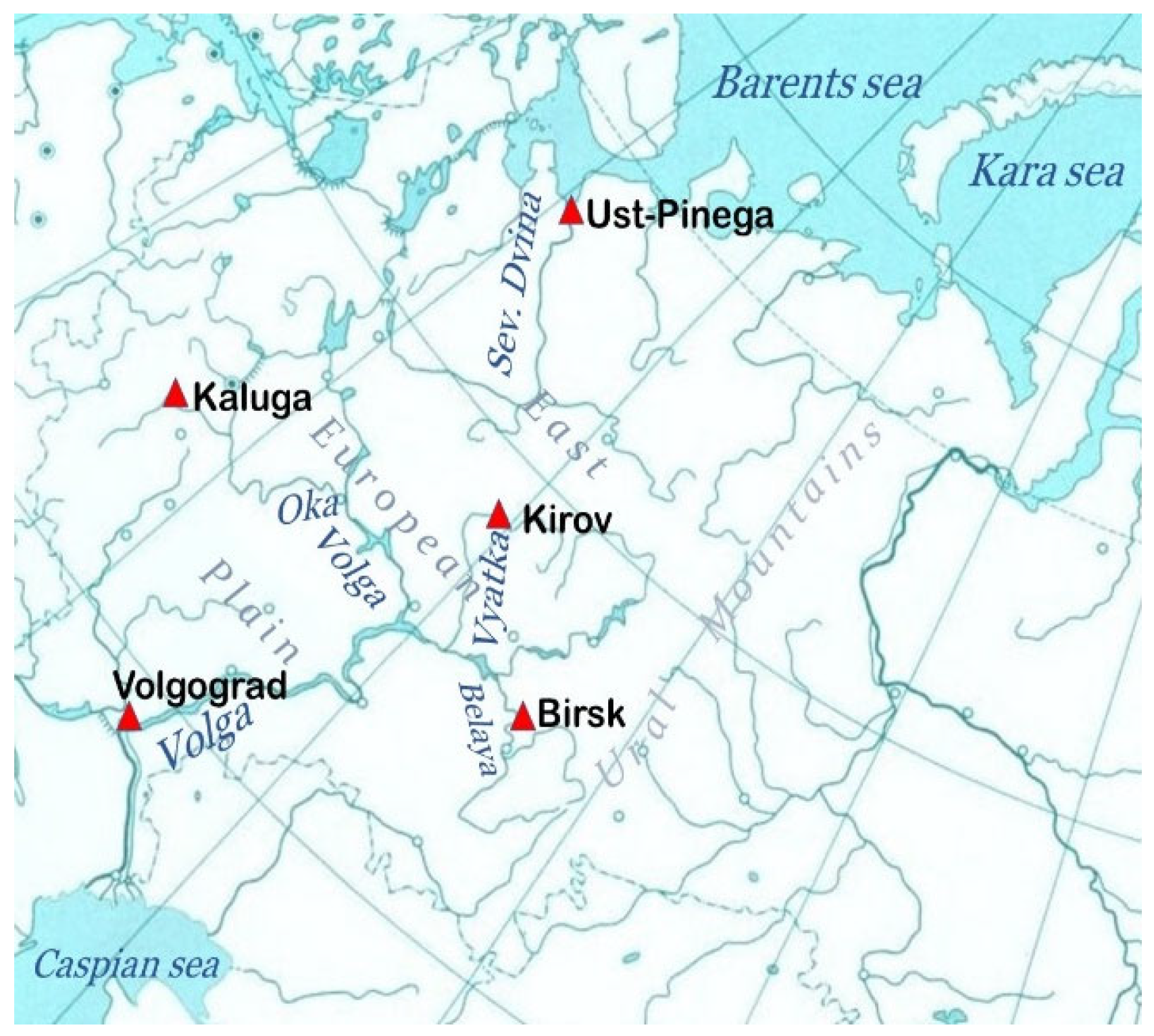


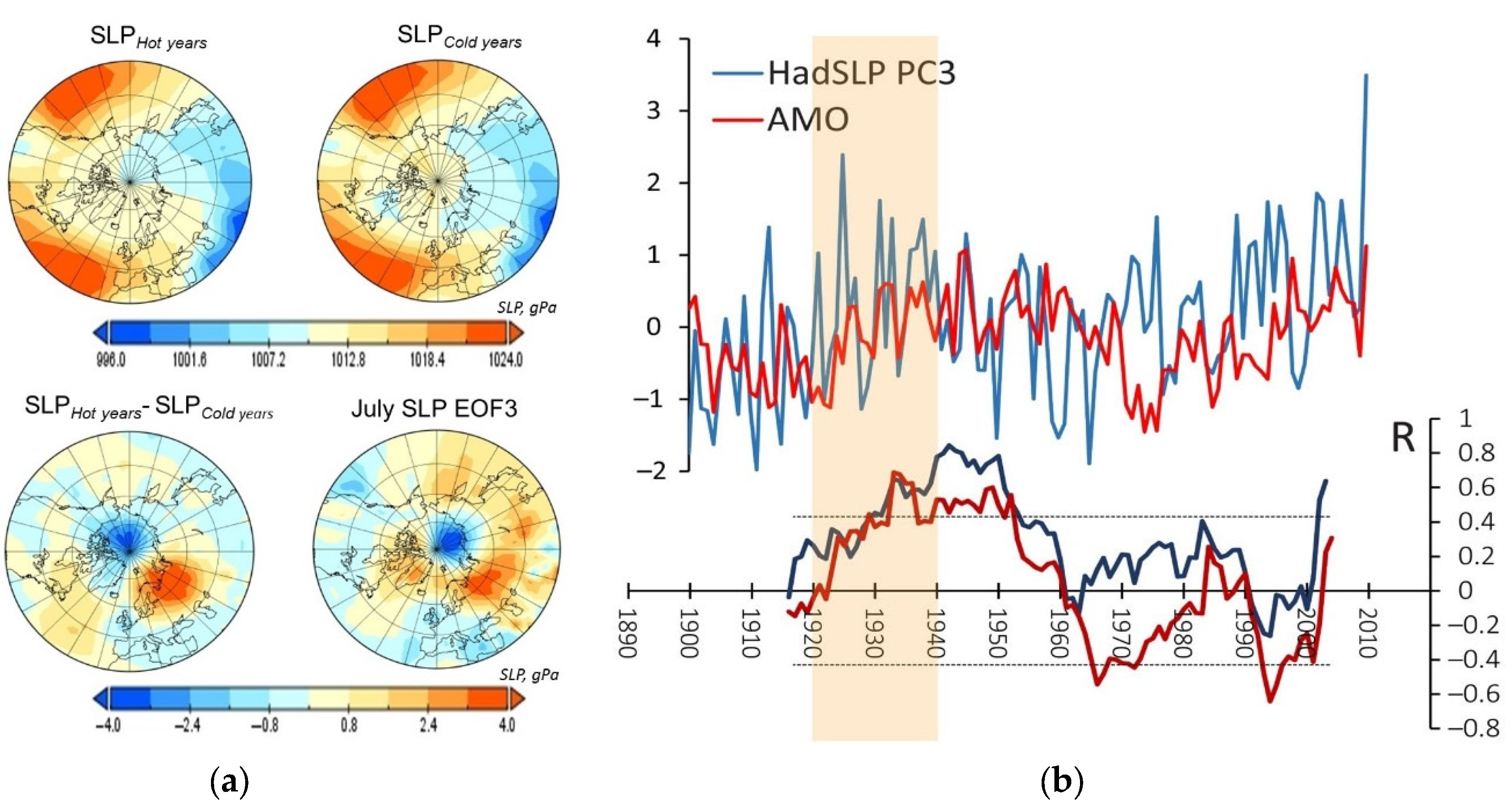
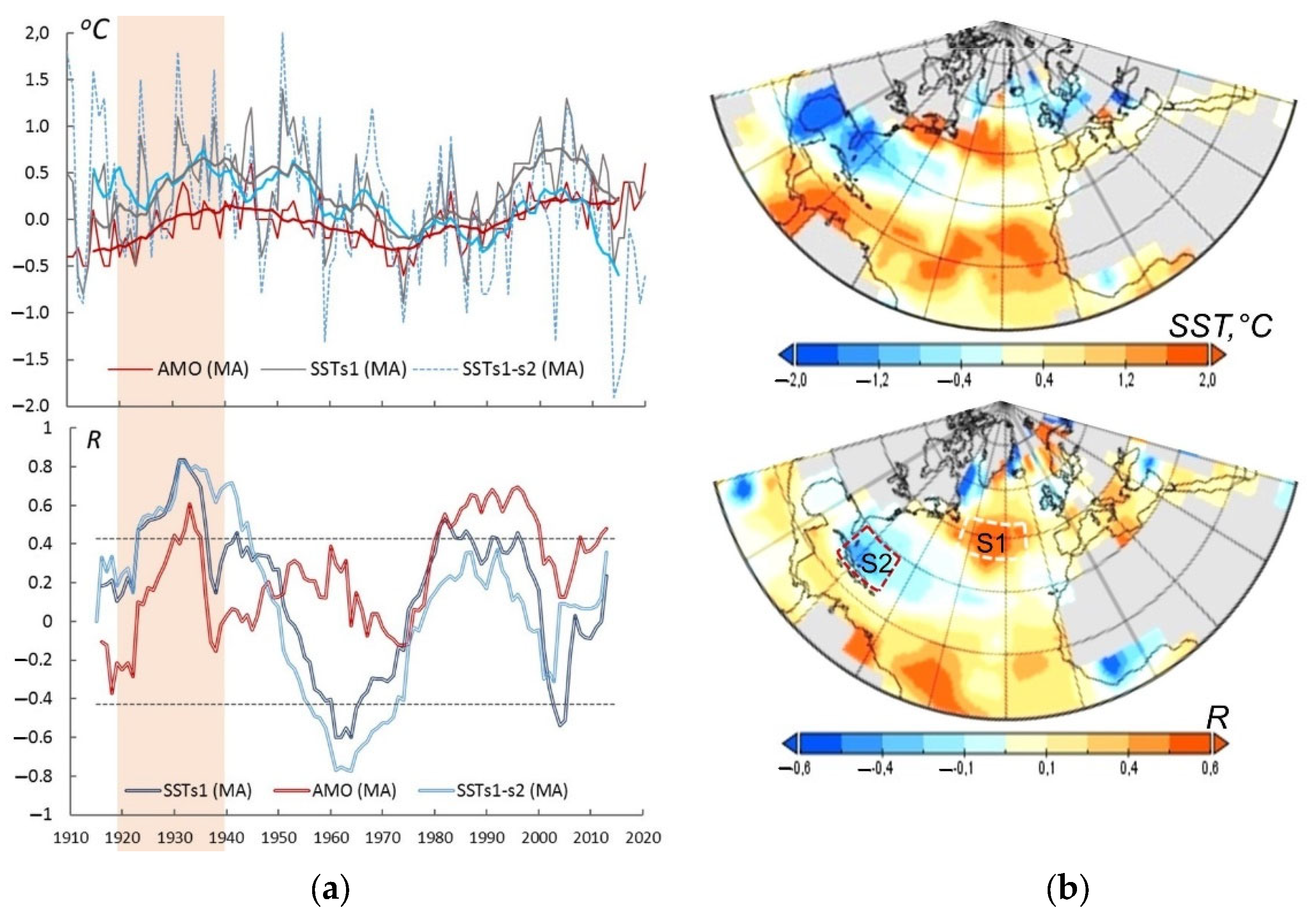

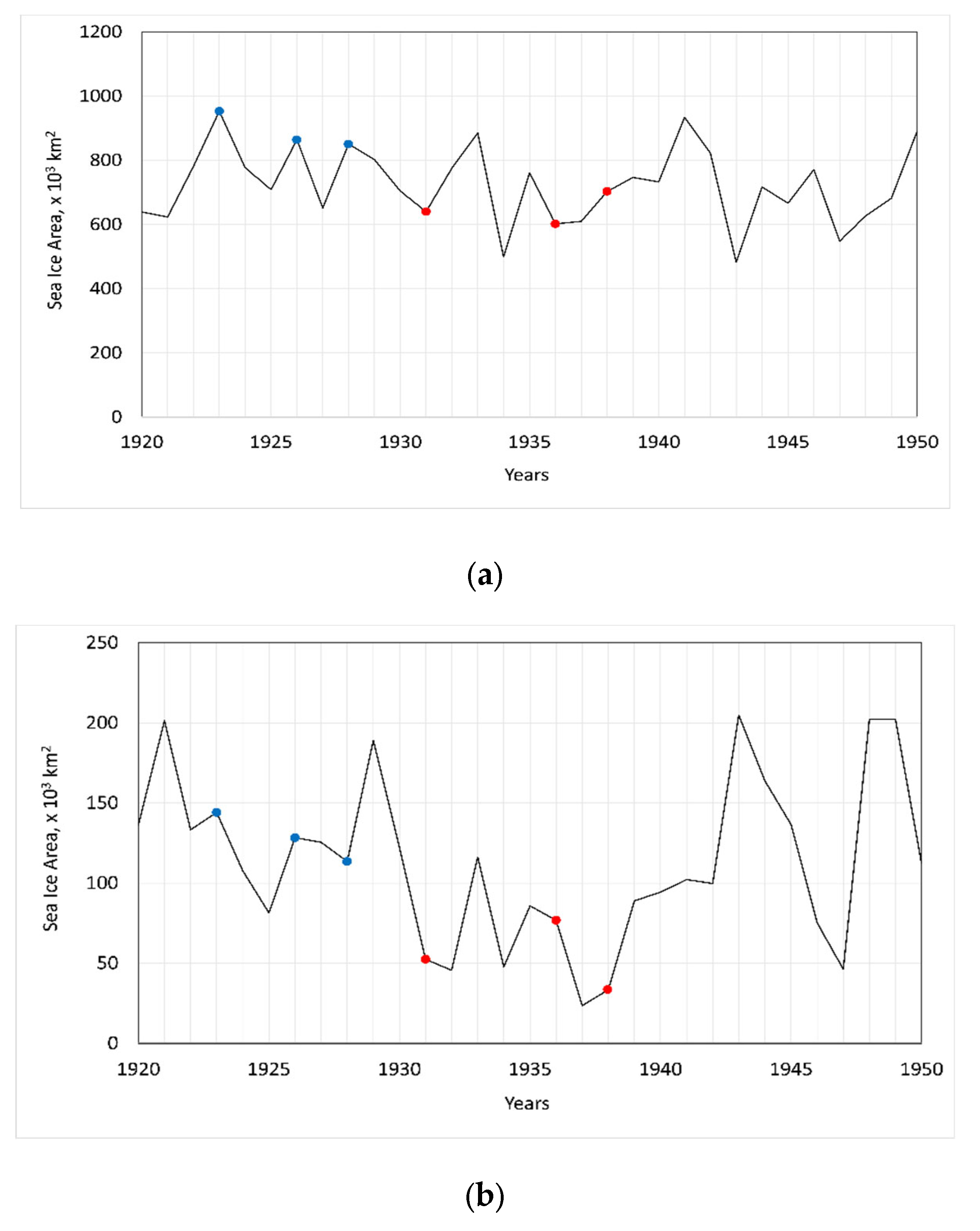

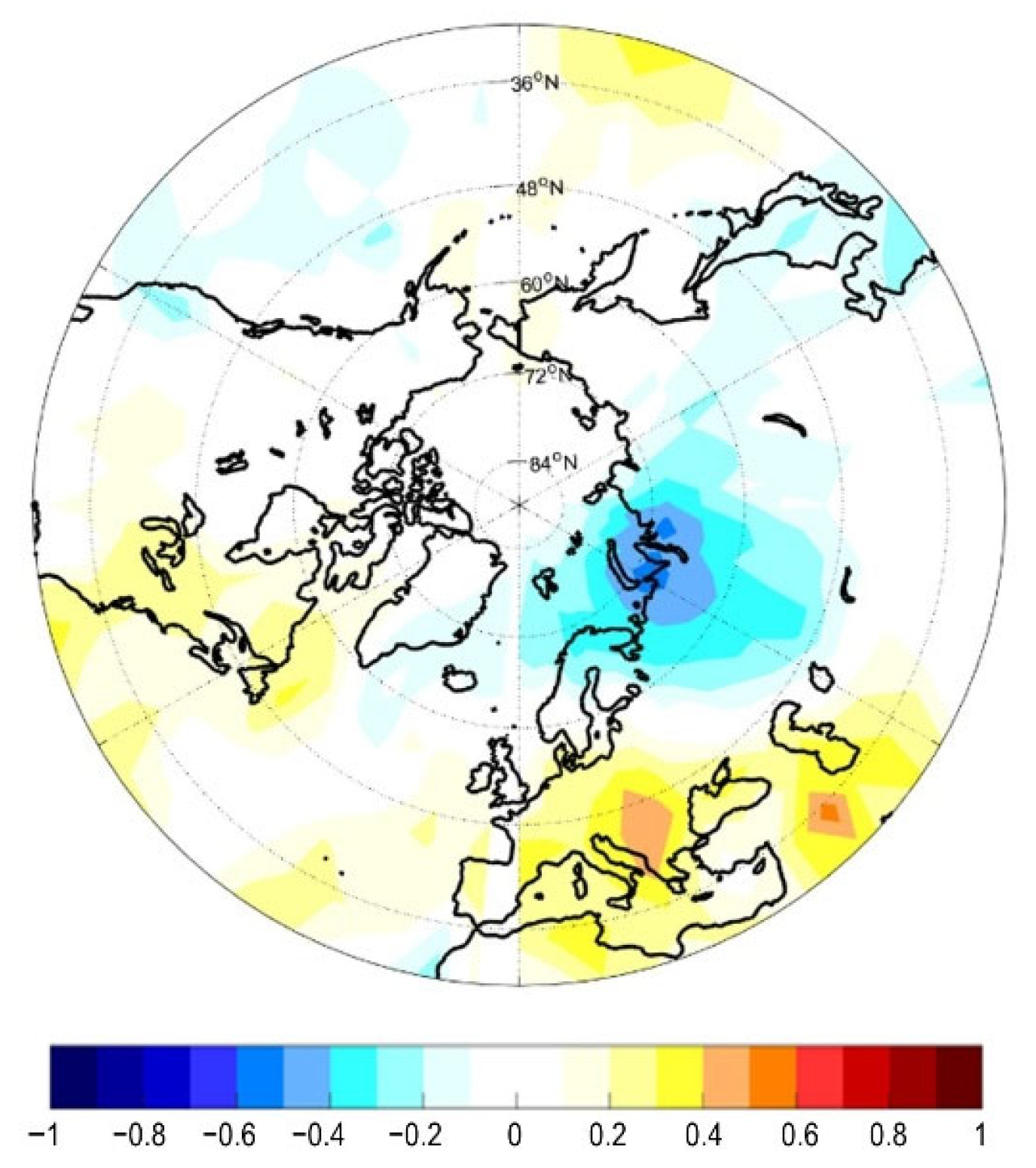
| Parameter | Years | AMO | SSTS1 | ΔSSTS1-S2 |
|---|---|---|---|---|
| AMO | 1910–2020 | - | 0.68 | 0.36 |
| SATEEP | 1923–1950 | 0.27 | 0.53 | 0.59 |
| SATEEP | 1980–2000 | 0.61 | 0.50 | 0.41 |
| BS ice area | 1923–1940 | −0.25 | −0.48 | −0.34 |
Disclaimer/Publisher’s Note: The statements, opinions and data contained in all publications are solely those of the individual author(s) and contributor(s) and not of MDPI and/or the editor(s). MDPI and/or the editor(s) disclaim responsibility for any injury to people or property resulting from any ideas, methods, instructions or products referred to in the content. |
© 2023 by the authors. Licensee MDPI, Basel, Switzerland. This article is an open access article distributed under the terms and conditions of the Creative Commons Attribution (CC BY) license (https://creativecommons.org/licenses/by/4.0/).
Share and Cite
Popova, V.; Aldonina, T.; Bokuchava, D. Manifestation of the Early 20th Century Warming in the East-European Plain: Atmospheric Circulation Anomalies and Its Connection to the North Atlantic SST and Sea Ice Variability. Atmosphere 2023, 14, 428. https://doi.org/10.3390/atmos14030428
Popova V, Aldonina T, Bokuchava D. Manifestation of the Early 20th Century Warming in the East-European Plain: Atmospheric Circulation Anomalies and Its Connection to the North Atlantic SST and Sea Ice Variability. Atmosphere. 2023; 14(3):428. https://doi.org/10.3390/atmos14030428
Chicago/Turabian StylePopova, Valeria, Tatiana Aldonina, and Daria Bokuchava. 2023. "Manifestation of the Early 20th Century Warming in the East-European Plain: Atmospheric Circulation Anomalies and Its Connection to the North Atlantic SST and Sea Ice Variability" Atmosphere 14, no. 3: 428. https://doi.org/10.3390/atmos14030428
APA StylePopova, V., Aldonina, T., & Bokuchava, D. (2023). Manifestation of the Early 20th Century Warming in the East-European Plain: Atmospheric Circulation Anomalies and Its Connection to the North Atlantic SST and Sea Ice Variability. Atmosphere, 14(3), 428. https://doi.org/10.3390/atmos14030428




